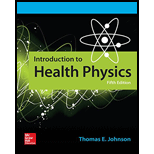
Concept explainers
(a)
The relative proportions of the two groups after passing through 25 cm of water.
(a)
Answer to Problem 5.35P
The relative proportions of the two groups after passing through 25 cm of water is,
Explanation of Solution
Given:
Energy,
Energy,
Thickness,
Cross-section,
Cross-section,
Cross-section,
Cross-section,
Formula used:
The intensity of gamma beam through the absorber curve is,
Where,
x =Thickness
Calculation:
The number of Hydrogen atoms per cm3 is,
The number of Oxygen atoms per cm3 is,
For Energy,
The intensity is given by
For Energy,
The intensity is given by
The relative proportions of the two groups after passing through 25 cm of water is,
Conclusion:
The relative proportions of the two groups after passing through 25 cm of water is,
(b)
The relative proportions of the two groups after passing through a slab of lead of the same density thickness.
(b)
Answer to Problem 5.35P
The relative proportions of the two groups after passing through 25 cm of water is
Explanation of Solution
Given:
Energy,
Energy,
Density thickness,
Cross-section,
Cross-section,
Cross-section,
Cross-section,
Cross-section,
Cross-section,
Cross-section,
Cross-section,
Formula used:
The intensity of gamma beam through the absorber curve is,
Where,
x =Thickness
The thickness is given by,
Calculation:
The thickness is given by,
For energy 1 MeV
Number of Pb-204 atoms are,
So,
Number of Pb-206 atoms are,
So,
Number of Pb-207 atoms are,
So,
Number of Pb-208 atoms are,
So,
Thus,
The intensity is given by:
For energy 10 MeV
Number of Pb-204 atoms are,
So,
Number of Pb-206 atoms are,
So,
Number of Pb-207 atoms are,
So,
Number of Pb-208 atoms are:
So,
Thus,
The intensity is given by
The relative proportions of the two groups after passing through 25 cm of water is,
Conclusion:
The relative proportions of the two groups after passing through 25 cm of water is:
Want to see more full solutions like this?
Chapter 5 Solutions
Introduction To Health Physics
- A parallel beam of 10-MeV neutrons is normally incident on a layer of water, 0.5 cm thick. Ignore neutron collisions with oxygen and multiple collisions with hydrogen. (a) How many neutron collisions per second deposit energy at a rate of 10–7 J s–1? (b) How many incident neutrons per second are needed to produce this rate of energy deposition?arrow_forwardWhat thickness of aluminum is required to reduce 200Kev gamma rays to 10% of its original value? Note that the thickness of half the value at energy Kev 200 in aluminum is 2.14 cmarrow_forwardIf the average energy released in a fission event is 208 MeV, find the total number of fission events required to operate a 120-W lightbulb for 2.0 h. fission eventsarrow_forward
- A large power reactor that has been in operation for some months is turned off, but residual activity in the core still produces 150 MW of power. If the average energy per decay of the fission products is 0.96 MeV, what is the core activity in units of curies?arrow_forwardThe electrical power output of a large nuclear reactorfacility is 900 MW. It has a 35.0% efficiency in convertingnuclear power to electrical.(a) What is the thermal nuclear power output in megawatts?(b) How many 235U nuclei fission each second, assumingthe average fission produces 200 MeV?(c) What mass of 235U is fissioned in one year of full-poweroperation?arrow_forwardWhy can heavy nuclei with odd numbers of neutrons be induced to fission with thermal neutrons, whereas those with even numbers of neutrons require more energy input to induce fission?arrow_forward
- In a particular fission event in which 235U is fissioned by slow neutrons, no neutron is emitted and one of the primary fission fragments is 83Ge. (a) What is the other fragment? The disintegration energy is Q = 170 MeV. How much of this energy goes to (b) the 83Ge fragment and (c) the other fragment? Just after the fission, what is the speed of (d) the 83Ge fragment and (e) the other fragment?arrow_forwardIf the average energy released in a fission event is 208 MeV, find the total number of fission events required to operate a 100.-W lightbulb for 1.0 h.arrow_forwardVerify that, as stated in Module 43-1, neutrons in equilibrium with matter at room temperature, 300 K, have an average kinetic energy of about 0.04 eV.arrow_forward
- What initial mass of 235 over 92 U is required to operate a 950-MWMW reactor for 1 yryr? Assume that 200 MeVMeV is released per per fission and 34%% efficiency.arrow_forwardHow much energy in MeV would be required to completely dissociate the uranium-235 nucleus (atomic mass=235.043923), into its components’ protons and neutrons?arrow_forwardCalculate neutron separation energies for the isotopes of Pb from A = 198 to 212 and plot them.arrow_forward
 Modern PhysicsPhysicsISBN:9781111794378Author:Raymond A. Serway, Clement J. Moses, Curt A. MoyerPublisher:Cengage Learning
Modern PhysicsPhysicsISBN:9781111794378Author:Raymond A. Serway, Clement J. Moses, Curt A. MoyerPublisher:Cengage Learning
